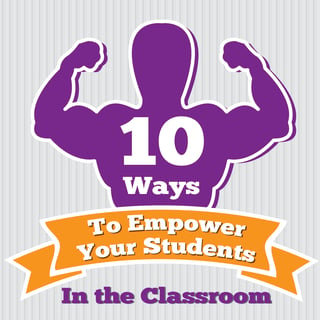
1. Involve Students in Classroom Curriculum Planning
At the beginning of each semester, give students a chance to voice their opinions about how they would like to learn about the topics you have planned for the semester. Prompt them with questions: What ways have they enjoyed learning in the past? What was their favorite activity from last semester, and why? A few specific questions can get the dialogue rolling and give you greater insight into their thoughts. Afterwards, think about how you might incorporate their ideas without changing the core curriculum. Use their feedback to create a plan to engage them in topics they are excited about and encourage them in topics they find difficult.
2. Give Students an Opportunity to Make Their Own Decisions About How to Present Their Work
One of the best ways to empower students is to give them options for how they might present their projects and assessments to you and the class. For example, students might turn in their projects via an oral presentation done at the front of the classroom, a recording of the presentation (a video using a mobile device or document camera), or a written format that is shared with the class using Google docs. Students will choose the method that works best for them, which will help them learn the material better. While offering different options is good, you may sometimes want to push them outside of their comfort zone by eliminating an option they repeatedly choose.
3. Encourage Students to Use Technology in the Classroom with Meaningful Applications
Technology is becoming increasingly important in the classroom as it grows and evolves. Technology allows students to share and present their work to the whole classroom. It helps them make their work more engaging and interactive using screen grabs, Web links, or recorded video and images from document cameras and mobile devices. Encourage students to take an assignment and come up with new ways to make it more dynamic and to share it, to encourage more collaboration among their peers.
4. Create Guided Assignments for Your Students to Do Before You Teach the Lesson in Class
This technique works best for math and science lessons, but can be useful for teaching any subject. By giving students easy-to-follow guided assignments before you teach them the complete lesson in class, you enable them to teach themselves, inspire confidence in their abilities, and help them prepare questions about the material in advance.
5. Give Students a Guided Place to Ask Questions and Discuss Curriculum
Many students don’t ask all the questions they have during class, so when they get home and start doing their homework, they are left confused and without access to help until the next day. By creating and monitoring a forum or online discussion board, you can give students the extra help they need when they can’t ask questions in person, and a controlled place where they can help each other online while they’re doing their homework.
6. Create a Theme for Your Classroom
By altering the appearance of your classroom for a special theme, you can create an atmosphere that will excite your students every day. You can even use your theme to make your lessons more interesting and relate them to real-world applications. Change the theme once a month and have the students help create the stations or decorations that will fuel that theme and their learning.
7. Find Out What Your Students Are Passionate About and Use Those Things to Inspire Their Learning
Taking the age group of your students into account, find a cause or news story that interests them, and focus on it in your lessons as a theme for a week. Give students a way to connect what they’re passionate about with their studies. For example, give an economics lesson on how to fix the budget of your local animal shelter, or a science lesson on the environmental importance of recycling.
8. Create Your Own “Essential 55” Like Educator Ron Clark
If you teach older students, come up with your own set of classroom rules and attitudes, like Ron Clark’s “Essential 55,” and hold both your students and yourself accountable for following these rules. Students will feel invested when you show them that you are on the same page with them, and this will positively affect the environment and mood of your classroom.
9. Give Students an Opportunity to Share Exceptional Work with Their Peers
For bigger projects and assignments, let students know that you will choose a few standouts to be shared with the class. Students will put more into their work when they know that they may get to share it with their peers. By choosing certain students to share their work, you will simultaneously inspire confidence in those students and motivate other students to work harder in hopes of sharing their work next time they get a chance.
10. Enable Students to Self-Assess Their Work
Many schools participate in student-teacher conferences, but a great way to involve your students is to go a step further and allow them to assess themselves regularly. When you learn how students think they are doing, you can give them specific resources to help them be more successful. Students will also feel that their opinions are being heard, and will be more comfortable communicating with you in the future.
Like these ideas? Want to connect and share lessons and ideas with other educators? Become a member of the MimioConnect® online educator community.